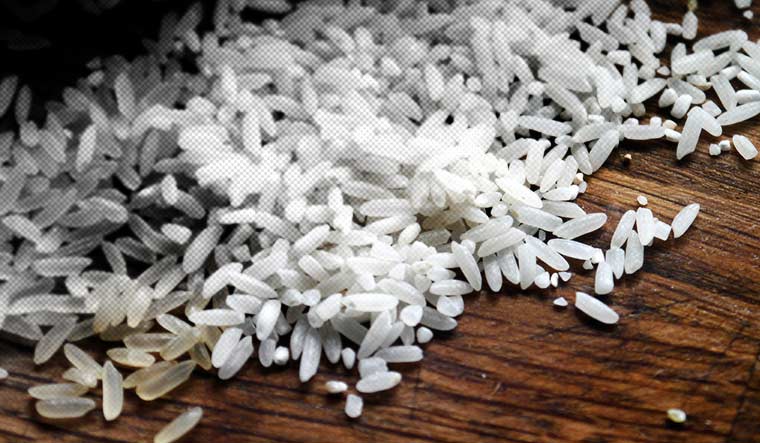The future looks grim for rice as we know it. It supplies 25 per cent of global calories and half the world’s population depends on it as a basic food.
For much of the developing world, rice is a key to human survival. But at the same time, climate change is poised to create a negative feedback loop—making it harder and more intensive to grow the grain, even as the number of people in need of food security is expected to increase.
Production of rice is also responsible for 12 per cent of methane emissions globally, and 2.5 per cent of global human-induced greenhouse gas emissions. And the more the world warms, the worse things get for rice-growers. Rainfall during the rice-growing period decreased by 7 per cent annually over the past 30 years, according to an EPW report, with significant climate change expected to lower rice yield by 8.10 per cent by 2080.
The water-intensive crop—which requires around 2,800 litres of water for every kilogram produced—could add to a water crisis by 2030, when demand is expected to outpace supply by a factor of two, according to a 2019 WaterAid India report.
Not only are rice yields expected to decline as temperatures rise, but the increase in CO2 in the atmosphere has also cut down on its nutritional content. A 2019 study published in Science noted that higher CO2 levels have resulted in a decline in protein, micronutrient, and vitamin content in rice strains—with potential health consequences for the 600 million people who get over half of their per capita dietary energy from rice.
In India, this leads to a difficult conversation. Nearly half the population works in agriculture, with rice as their main output. 2021 saw rice production reach record levels with about 125 million tonnes of rice expected to be produced from both the summer and winter crops.
India, one of the world’s top three methane emitters and the world’s leading exporter of rice, abstained from signing the Global Methane Pledge to cut down on emissions of greenhouse gas by 30 per cent by 2030. India has also not signed up to the COP26 Action Agenda on Sustainable Agriculture. The reasons could be down to India’s long-maintained stance: Developing nations have a responsibility to feed and sustain their own citizens, and should not bear the brunt of responsibility to tackle the results of “historical” carbon emissions.
ALSO READ: COP26: Why India chose to stay away from pledge to limit methane and stop deforestation
The simple reality is that with more mouths to feed, there is more food that needs to be grown. Making this production sustainable will require more than a change of crop, but a transformation of mindset.
Grow different, eat different
What happens if you replace rice? The use of alternative cereals, like maize, finger millet (ragi), pearl millet or sorghum, with low-irrigation requirements, could cut India’s irrigation demand by 33 per cent, according to a 2018 study in Science Advances.
One argument is that farmers can diversify production, shifting from industrial rice production in the so-called “rice bowls” to mixed cropping, and make use of organic farming to lessen the climate impact and increase the overall sustainability. Thinking in terms of permaculture and subsistence agriculture can help turn Indian farming into a more sustainable affair.
But this transition cannot happen overnight, says Partha Varanashi, a swimming coach and organic farmer with a background in molecular plant biotechnology.
He points to his family’s 200-year-history of mixed cultivation as an example.
“Earlier, every farmer used to cultivate rice. Over time they switched to cash crops, as the price of rice dropped as cultivation shifted towards industrial production in the rice bowls.”
Since 1990, Varanashi Farms in Karnataka’s Dakshina Kannada district has turned to organic methods, rebuilding forest ecosystems and encouraging sustainable practices.
This industrial production of rice compounds the problem of its sustainability. Varanashi explains that as farmers sought higher yields, they resorted to adding high amounts of chemical fertilisers to the soil, killing microorganisms that are normally part of the process of converting organic matter into usable nutrients for soil and plants. With these micro-organisms dead, the crops get dependent on chemical farming. “This has stopped that cycle of getting NPK from plant and animal waste,” he says.
Transitioning out of this will take time to alter soil composition back to natural levels, he says, through methods like using cow dung slurry, green manures, inoculation of beneficial microorganisms in the form of biofertilizer to enrich soil nutrients, bio-control agents to tackle pests, and growing rice just once a year in a smaller field. And, importantly, growing and eating alternative crops such as millets and lentils besides rice to be ecological balance.
“In my opinion, as a high-performance swimming coach, who works with national athletes I've observed the need to approach fitness through diet: Consume a variety of food rather than just rice as a staple. Your body needs a 3:1 ratio of carbohydrates to protein. Rice has a 20:1 (28g carbs, 2.7g protein) ratio. The nutrition from a diet of millets, green gram and black grams is much closer to this 3:1 ratio. When we consume higher quality food as staples, the amount of food we need to eat reduces exponentially," Varanashi says.
Changing food habits could prove an efficient solution to hunger and land utilisation. “We have to grow a lot of rice because you have to feed everybody. If you change the quality of food, you can feed them six times less but the result is better nutrition, less obesity,” he says.
When picking which activity has the most effect on the environment, context proves the devil in the details. While rice is a polluter, it’s far from being the worst one. Meat and dairy products alone account for 14.5 per cent of global greenhouse gas emissions, according to the UN’s Food and Agricultural Organization (FAO). While rice may seem replaceable, it’s far from the first time humans need to change: Before we change how and what farmers grow, there is a pressing need to ensure that fossil fuels stay underground.
The reality of climate change, however, is that agriculture will be one of its first casualties. Both preventing and surviving a post-1.5-degree world may necessitate a transition from rice.


